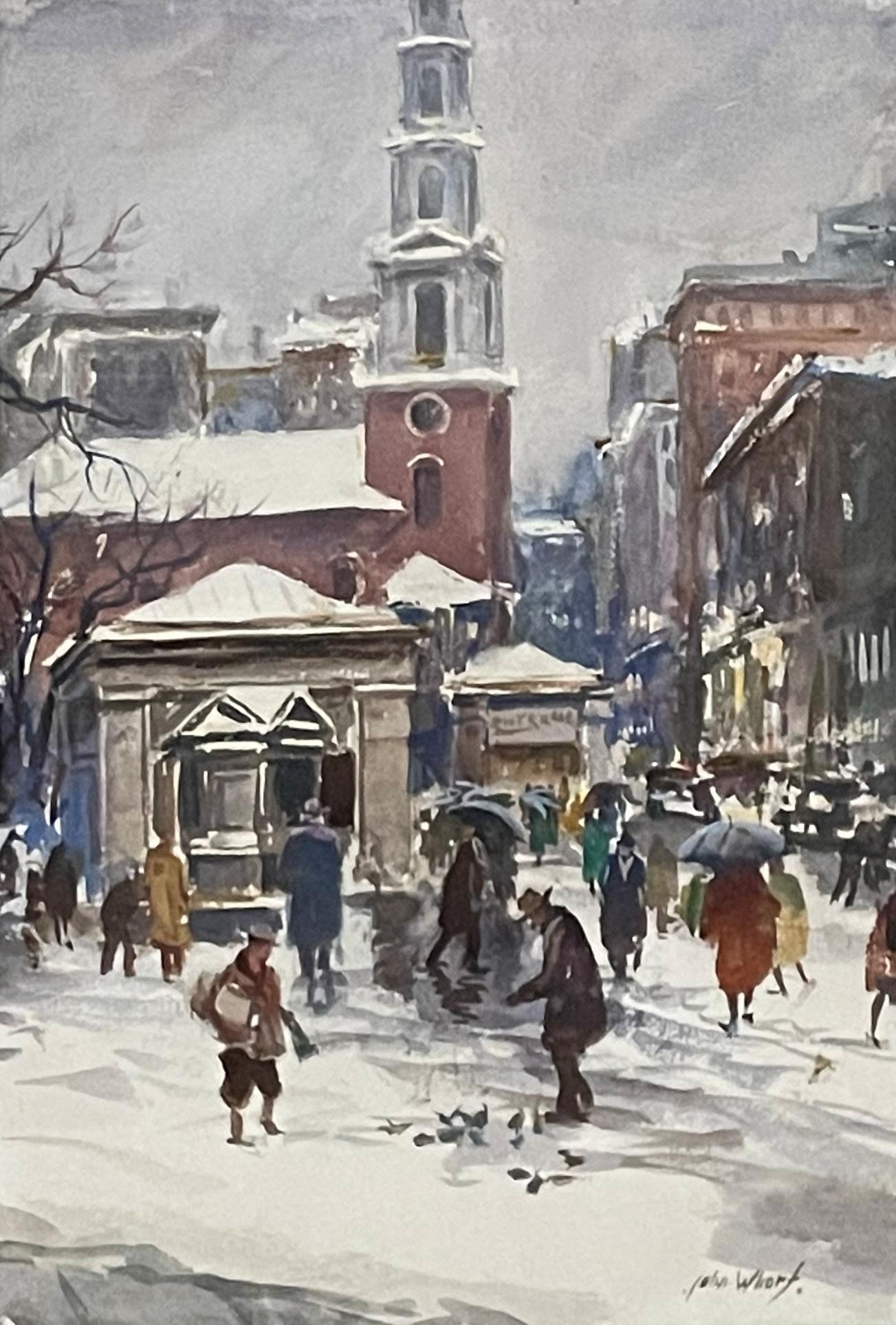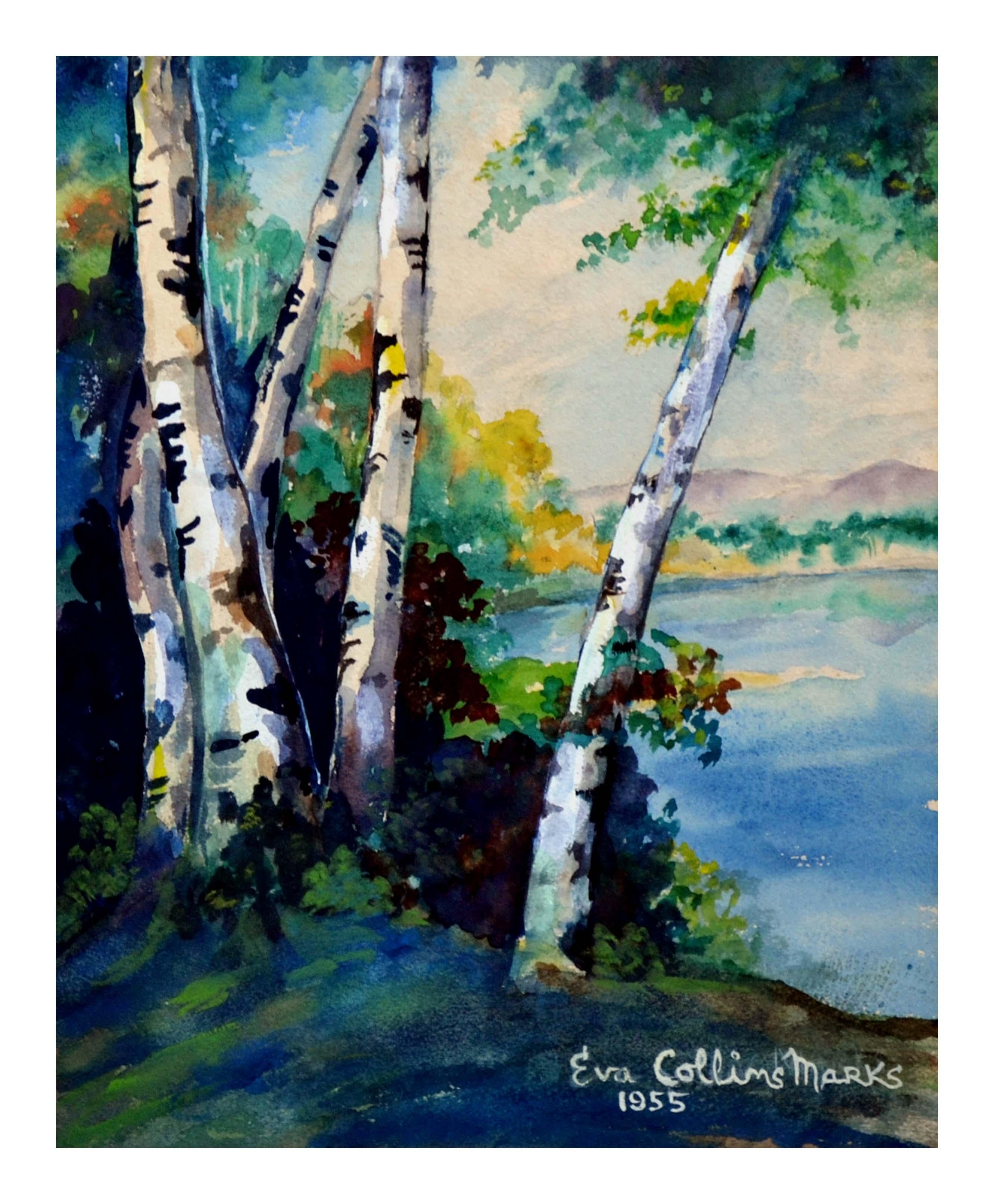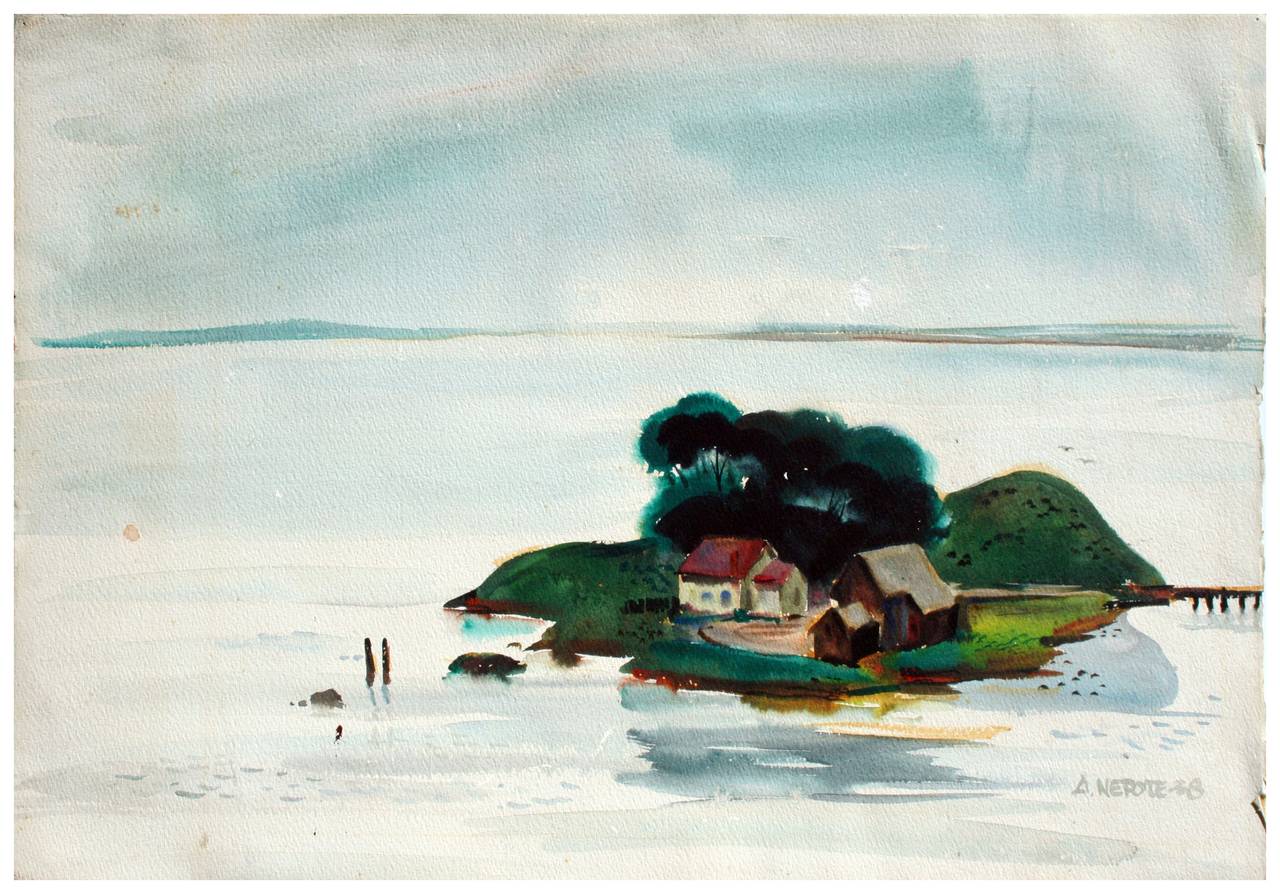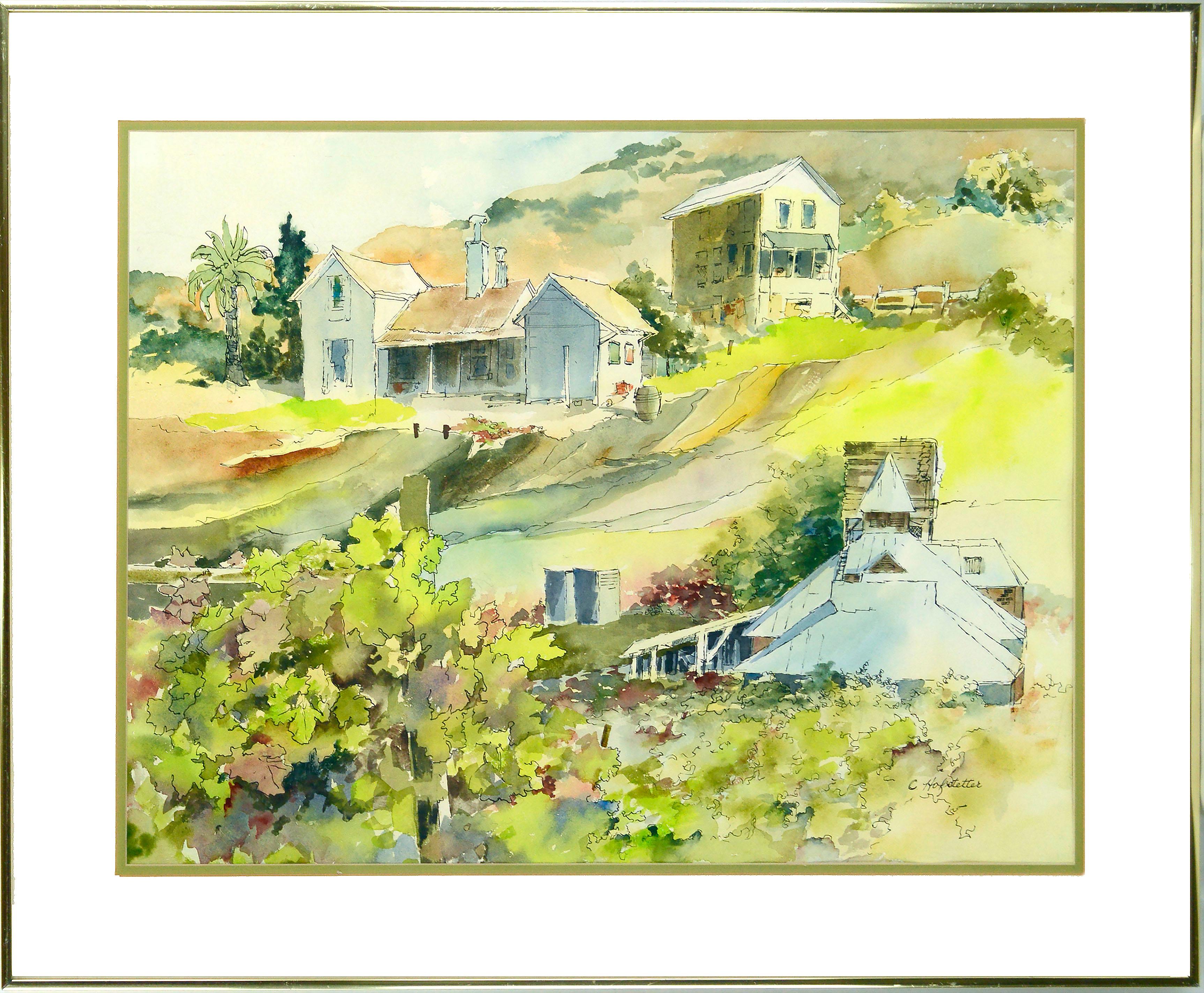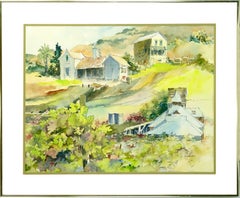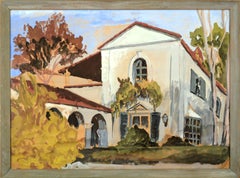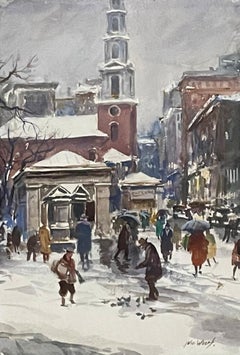
Midcentury Country Lane Landscape
View Similar Items
Want more images or videos?
Request additional images or videos from the seller
1 of 8
V BurnettMidcentury Country Lane Landscape1964
1964
About the Item
- Creator:V Burnett
- Creation Year:1964
- Dimensions:Height: 22.63 in (57.49 cm)Width: 29.25 in (74.3 cm)Depth: 1.13 in (2.88 cm)
- Medium:
- Movement & Style:
- Period:
- Condition:Art, excellent. Rustic wood frame. Old mat board needs to be replaced.
- Gallery Location:Soquel, CA
- Reference Number:Seller: JT-S23051stDibs: LU5423272641
About the Seller
5.0
Platinum Seller
These expertly vetted sellers are 1stDibs' most experienced sellers and are rated highest by our customers.
Established in 1986
1stDibs seller since 2014
2,506 sales on 1stDibs
More From This SellerView All
- California Vineyard, Large-Scale Farmhouse Landscape WatercolorBy Carolyn HofstetterLocated in Soquel, CAVibrant large-scale landscape watercolor of a California vineyard by S.W.A. artist Carolyn Hofstetter (American, b.1927). This beautiful scene of ...Category
Late 20th Century American Impressionist Landscape Drawings and Watercolors
MaterialsPaper, Watercolor
- Mid Century California Mission LandscapeLocated in Soquel, CABeautiful mid century landscape of a historic California mission, highlighting its iconic architectural details such as a columned arches, white was...Category
Mid-20th Century American Impressionist Landscape Paintings
MaterialsGouache, Cardboard, Paper
- Island in the San Francisco Bay, Mid Century Landscape by Alexander NepoteBy Alexander NepoteLocated in Soquel, CAMid Century Island in the San Francisco Bay Landscape by Alexander Nepote Lovely late 1930's Impressionist watercolor of a Bay Area island b...Category
1930s American Impressionist Landscape Paintings
MaterialsPaper, Watercolor
- Pt. Pinos California, Coastal Figural Landscape WatercolorBy Donald J. PhillipsLocated in Soquel, CAPt. Pinos California, Coastal Figural Landscape Watercolor Striking depiction of a lighthouse by Donald J. Phillips (American, 20th Century). Signed and dated "DONALD J. PHILLIPS WW/7-89" in the lower right corner. Tag on verso with artist and exhibition information. Presented in a double mat of white and cream, in a green metal frame with glass. Image size: 21"H x 15"W Donald J. Phillips (American, 20th Century) is an artist from San Leandro, CA. He attended California College of Arts and Crafts in Oakland, where he met his wife. Phillips served in Marine Corps Reserve and was called to duty from 1950-1951 during the Korean War. Exhibitions and Memberships: 21st Annual Santa Cruz Art Exhibit, 1950 New England Watercolor...Category
1980s American Impressionist Landscape Drawings and Watercolors
MaterialsWatercolor, Paper
- Mid Century River Birches Landscape WatercolorLocated in Soquel, CAMid Century River Birches Landscape Watercolor Gorgeous vibrant mid century watercolor on paper painting of river birch trees by artist Eva Collins Marks (American, 20th century),19...Category
1950s American Impressionist Landscape Paintings
MaterialsPaper, Watercolor
- Village in the Ural Mountains - Mid Century LandscapeLocated in Soquel, CADetailed and vibrant mid century mountain village landscape by an unknown artist. Signed ("Dosa" or "Josa") and dated ("47") in the lower ri...Category
1940s Impressionist Landscape Paintings
MaterialsPaper, Gouache, Watercolor
You May Also Like
- "River Landscape" Julian Alden Weir, American Impressionist, Connecticut SceneBy Julian Alden WeirLocated in New York, NYJulian Alden Weir River Landscape Signed lower left Watercolor on paper 9 x 11 1/2 inches Provenance: Kraushaar Galleries, New York Sotheby's Parke Bernet, New York, 1965, Lot 27 E....Category
Late 19th Century American Impressionist Landscape Drawings and Watercolors
MaterialsWatercolor, Paper
- "Old Adobe Village, New Mexico" Alice Schille, Taos Pueblo, Female ImpressionistBy Alice SchilleLocated in New York, NYAlice Schille Old Adobe Village, New Mexico Signed lower right Watercolor on paper 5 x 6 inches Provenance: Estate of the artist Keny and Johnson Gallery, Columbus, Ohio Santa Fe East Galleries, Santa Fe, New Mexico Private Collection, California A painter in watercolor and oil, Alice Schille was a prolific artist using modernist styles of Post-Impressionism, Pointillism and Fauvism. Her subjects included portraits of women and children, landscapes with and without figures, a series of scenes of New York City. New Mexico, and Gloucester, Massachusetts. Her paintings also reflected her widespread international travels in Europe, North Africa, Russia, the Middle East, Mexico, and Guatemala. Although personally very shy, Schille possessed unusual courage and strength of will, which was reflected in both her independent lifestyle and in her work, as she continually worked to master new modes of painting throughout her career. A German critic once referred to Schille as "this daredevil disciple of art who is interested in anything and afraid of nothing." Alice Schille was born in Columbus, Ohio to a family supported by her father's success in manufacturing. She was raised in Columbus, and by the time she was age six, she determined to be an artist. She graduated at the top of her class from Central High School in 1887, studied from 1891 to 1893 at the Columbus Art School, and returned there as a teacher from 1902 to 1948. Going to New York City as a young woman, she enrolled in the Art Students League from 1897 to 1899 and then the New York School of Art with William Merritt Chase and Kenyon Cox. (Some years later, she attended Chase's Shinnecock Summer School on Long Island). From 1903 to 1904, Alice Schille was in Paris at the Academie Colarosi, and also studied privately with Raphael Collin, Rene Prinet, Gustave Courtois and Chase, who was then in Europe. In 1904, five of her paintings were accepted for exhibition at Societe Nationale des Beaux Arts, and from that time on her work was included regularly in important American annual exhibitions including the Pennsylvania Academy, the Corcoran Gallery, American Watercolor Society, Boston Art Club, and the 1987 inaugural exhibition of the National Museum of Women in the Arts in Washington DC. Between 1905 and 1914, Alice Schille painted in Europe, and during the summers of 1916 to 1918, worked in New York and Gloucester. In 1919, she was in New Mexico. On this trip, her first to the Southwest, she spent a summer in Taos and Santa Fe and painted scenes including the Taos Pueblo, Canyon Road and local Hispanic and Indian figures. Reportedly the Ranchos de Taos Church was one of her favorite subjects. Many of these New Mexico paintings were hung at annual exhibitions of the Philadelphia Water Color Club. Between 1920 and 1940, she traveled frequently in the summers, returning to New Mexico and going to Central America and Africa. In 1922, she began her first series of North-African watercolors...Category
1920s American Impressionist Landscape Drawings and Watercolors
MaterialsPaper, Watercolor
- "Park Street Church, Boston, " John Whorf Impressionist Watercolor WPA CityscapeBy John WhorfLocated in New York, NYJohn Whorf (1903 - 1959) Park Street Church, Boston, circa 1930-45 Watercolor on paper 21 x 15 inches Signed lower right Housed in its original frame Provenance: Milch Gallery, New ...Category
1930s American Impressionist Landscape Drawings and Watercolors
MaterialsWatercolor, Paper
- "Monhegan Island, Maine, " Edward Dufner, American Impressionism Landscape ViewBy Edward DufnerLocated in New York, NYEdward Dufner (1872 - 1957) Monhegan Island, Maine Watercolor on paper Sight 16 x 20 inches Signed lower right With a long-time career as an art teacher and painter of both 'light' and 'dark', Edward Dufner was one of the first students of the Buffalo Fine Arts Academy to earn an Albright Scholarship to study painting in New York. In Buffalo, he had exchanged odd job work for drawing lessons from architect Charles Sumner. He also earned money as an illustrator of a German-language newspaper, and in 1890 took lessons from George Bridgman at the Buffalo Fine Arts Academy. In 1893, using his scholarship, Dufner moved to Manhattan and enrolled at the Art Students League where he studied with Henry Siddons Mowbray, figure painter and muralist. He also did illustration work for Life, Harper's and Scribner's magazines. Five years later, in 1898, Dufner went to Paris where he studied at the Academy Julian with Jean-Paul Laurens and privately with James McNeill Whistler. Verification of this relationship, which has been debated by art scholars, comes from researcher Nancy Turk who located at the Smithsonian Institution two 1927 interviews given by Dufner. Turk wrote that Dufner "talks in detail about Whistler, about how he prepared his canvasas and about numerous pieces he painted. . . A great read, the interview puts to bed" the ongoing confusion about whether or not he studied with Whistler. During his time in France, Dufner summered in the south at Le Pouleu with artists Richard Emil Miller...Category
Early 20th Century American Impressionist Landscape Drawings and Waterco...
MaterialsPaper, Watercolor
$4,800 Sale Price20% Off - "Train Station, " Max Kuehne, Industrial City Scene, American ImpressionismBy Max KuehneLocated in New York, NYMax Kuehne (1880 - 1968) Train Station, circa 1910 Watercolor on paper 8 1/4 x 10 1/4 inches Signed lower right Provenance: Private Collection, Illinois Max Kuehne was born in Halle, Germany on November 7, 1880. During his adolescence the family immigrated to America and settled in Flushing, New York. As a young man, Max was active in rowing events, bicycle racing, swimming and sailing. After experimenting with various occupations, Kuehne decided to study art, which led him to William Merritt Chase's famous school in New York; he was trained by Chase himself, then by Kenneth Hayes Miller. Chase was at the peak of his career, and his portraits were especially in demand. Kuehne would have profited from Chase's invaluable lessons in technique, as well as his inspirational personality. Miller, only four years older than Kuehne, was another of the many artists to benefit from Chase's teachings. Even though Miller still would have been under the spell of Chase upon Kuehne's arrival, he was already experimenting with an aestheticism that went beyond Chase's realism and virtuosity of the brush. Later Miller developed a style dependent upon volumetric figures that recall Italian Renaissance prototypes. Kuehne moved from Miller to Robert Henri in 1909. Rockwell Kent, who also studied under Chase, Miller, and Henri, expressed what he felt were their respective contributions: "As Chase had taught us to use our eyes, and Henri to enlist our hearts, Miller called on us to use our heads." (Rockwell Kent, It's Me O Lord: The Autobiography of Rockwell Kent. New York: Dodd, Mead and Co., 1955, p. 83). Henri prompted Kuehne to search out the unvarnished realities of urban living; a notable portion of Henri's stylistic formula was incorporated into his work. Having received such a thorough foundation in art, Kuehne spent a year in Europe's major art museums to study techniques of the old masters. His son Richard named Ernest Lawson as one of Max Kuehne's European traveling companions. In 1911 Kuehne moved to New York where he maintained a studio and painted everyday scenes around him, using the rather Manet-like, dark palette of Henri. A trip to Gloucester during the following summer engendered a brighter palette. In the words of Gallatin (1924, p. 60), during that summer Kuehne "executed some of his most successful pictures, paintings full of sunlight . . . revealing the fact that he was becoming a colorist of considerable distinction." Kuehne was away in England the year of the Armory Show (1913), where he worked on powerful, painterly seascapes on the rocky shores of Cornwall. Possibly inspired by Henri - who had discovered Madrid in 1900 then took classes there in 1906, 1908 and 1912 - Kuehne visited Spain in 1914; in all, he would spend three years there, maintaining a studio in Granada. He developed his own impressionism and a greater simplicity while in Spain, under the influence of the brilliant Mediterranean light. George Bellows convinced Kuehne to spend the summer of 1919 in Rockport, Maine (near Camden). The influence of Bellows was more than casual; he would have intensified Kuehne's commitment to paint life "in the raw" around him. After another brief trip to Spain in 1920, Kuehne went to the other Rockport (Cape Ann, Massachusetts) where he was accepted as a member of the vigorous art colony, spearheaded by Aldro T. Hibbard. Rockport's picturesque ambiance fulfilled the needs of an artist-sailor: as a writer in the Gloucester Daily Times explained, "Max Kuehne came to Rockport to paint, but he stayed to sail." The 1920s was a boom decade for Cape Ann, as it was for the rest of the nation. Kuehne's studio in Rockport was formerly occupied by Jonas Lie. Kuehne spent the summer of 1923 in Paris, where in July, André Breton started a brawl as the curtain went up on a play by his rival Tristan Tzara; the event signified the demise of the Dada movement. Kuehne could not relate to this avant-garde art but was apparently influenced by more traditional painters — the Fauves, Nabis, and painters such as Bonnard. Gallatin perceived a looser handling and more brilliant color in the pictures Kuehne brought back to the States in the fall. In 1926, Kuehne won the First Honorable Mention at the Carnegie Institute, and he re-exhibited there, for example, in 1937 (Before the Wind). Besides painting, Kuehne did sculpture, decorative screens, and furniture work with carved and gilded molding. In addition, he designed and carved his own frames, and John Taylor Adams encouraged Kuehne to execute etchings. Through his talents in all these media he was able to survive the Depression, and during the 1940s and 1950s these activities almost eclipsed his easel painting. In later years, Kuehne's landscapes and still-lifes show the influence of Cézanne and Bonnard, and his style changed radically. Max Kuehne died in 1968. He exhibited his work at the National Academy of Design, the Art Institute of Chicago, the Carnegie Institute in Pittsburgh, the Memorial Art Gallery of the University of Rochester, and in various New York City galleries. Kuehne's works are in the following public collections: the Detroit Institute of Arts (Marine Headland), the Whitney Museum (Diamond Hill...Category
1910s American Impressionist Landscape Drawings and Watercolors
MaterialsPaper, Watercolor
- Canal at Indian Mound RoadBy Ben FenskeLocated in Sag Harbor, NYPainted during the 2015 Winter Equestrian Festival in Wellington, Florida. A black and white depiction of a canal, is barely recognizable, due to Fenske's wild brushstrokes and lack...Category
21st Century and Contemporary American Impressionist Landscape Paintings
MaterialsGouache, Paper
Recently Viewed
View AllMore Ways To Browse
Oak Tree Drawing
1940 Lane
Vintage Hawaii Photographs
Vintage Hawaiian Photographs
California Oak Trees
Vintage Wineries
Vintage Winery
Vintage Botanical Flower Drawings
Mid Century Hawaiian Home
Oak Tree Painting California
W Burnett
Virginia Burnett
H C Fox Watercolor
Edward Tucker
1960s Vintage Paper Dolls
Walter G Cleveland
Ruth Hoffman
Hercules Brabazon Brabazon

